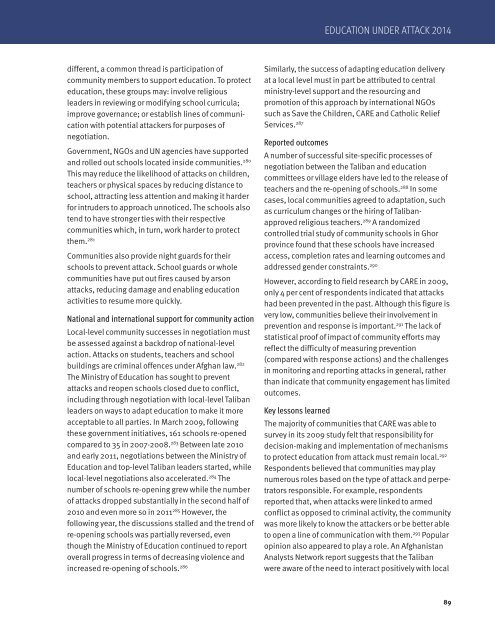Create successful ePaper yourself
Turn your PDF publications into a flip-book with our unique Google optimized e-Paper software.
EDUCATION UNDER ATTACK 2014<br />
different, a common thread is participation of<br />
community members to support education. To protect<br />
education, these groups may: involve religious<br />
leaders in reviewing or modifying school curricula;<br />
improve governance; or establish lines of communication<br />
with potential attackers for purposes of<br />
negotiation.<br />
Government, NGOs and UN agencies have supported<br />
and rolled out schools located inside communities. 280<br />
This may reduce the likelihood of attacks on children,<br />
teachers or physical spaces by reducing distance to<br />
school, attracting less attention and making it harder<br />
for intruders to approach unnoticed. The schools also<br />
tend to have stronger ties with their respective<br />
communities which, in turn, work harder to protect<br />
them. 281<br />
Communities also provide night guards for their<br />
schools to prevent attack. School guards or whole<br />
communities have put out fires caused by arson<br />
attacks, reducing damage and enabling education<br />
activities to resume more quickly.<br />
National and international support for community action<br />
Local-level community successes in negotiation must<br />
be assessed against a backdrop of national-level<br />
action. Attacks on students, teachers and school<br />
buildings are criminal offences under Afghan law. 282<br />
The Ministry of Education has sought to prevent<br />
attacks and reopen schools closed due to conflict,<br />
including through negotiation with local-level Taliban<br />
leaders on ways to adapt education to make it more<br />
acceptable to all parties. In March 2009, following<br />
these government initiatives, 161 schools re-opened<br />
compared to 35 in 2007-2008. 283 Between late 2010<br />
and early 2011, negotiations between the Ministry of<br />
Education and top-level Taliban leaders started, while<br />
local-level negotiations also accelerated. 284 The<br />
number of schools re-opening grew while the number<br />
of attacks dropped substantially in the second half of<br />
2010 and even more so in 2011 285 However, the<br />
following year, the discussions stalled and the trend of<br />
re-opening schools was partially reversed, even<br />
though the Ministry of Education continued to report<br />
overall progress in terms of decreasing violence and<br />
increased re-opening of schools. 286<br />
Similarly, the success of adapting education delivery<br />
at a local level must in part be attributed to central<br />
ministry-level support and the resourcing and<br />
promotion of this approach by international NGOs<br />
such as Save the Children, CARE and Catholic Relief<br />
Services. 287<br />
Reported outcomes<br />
A number of successful site-specific processes of<br />
negotiation between the Taliban and education<br />
committees or village elders have led to the release of<br />
teachers and the re-opening of schools. 288 In some<br />
cases, local communities agreed to adaptation, such<br />
as curriculum changes or the hiring of Talibanapproved<br />
religious teachers. 289 A randomized<br />
controlled trial study of community schools in Ghor<br />
province found that these schools have increased<br />
access, completion rates and learning outcomes and<br />
addressed gender constraints. 290<br />
However, according to field research by CARE in 2009,<br />
only 4 per cent of respondents indicated that attacks<br />
had been prevented in the past. Although this figure is<br />
very low, communities believe their involvement in<br />
prevention and response is important. 291 The lack of<br />
statistical proof of impact of community efforts may<br />
reflect the difficulty of measuring prevention<br />
(compared with response actions) and the challenges<br />
in monitoring and reporting attacks in general, rather<br />
than indicate that community engagement has limited<br />
outcomes.<br />
Key lessons learned<br />
The majority of communities that CARE was able to<br />
survey in its 2009 study felt that responsibility for<br />
decision-making and implementation of mechanisms<br />
to protect education from attack must remain local. 292<br />
Respondents believed that communities may play<br />
numerous roles based on the type of attack and perpetrators<br />
responsible. For example, respondents<br />
reported that, when attacks were linked to armed<br />
conflict as opposed to criminal activity, the community<br />
was more likely to know the attackers or be better able<br />
to open a line of communication with them. 293 Popular<br />
opinion also appeared to play a role. An Afghanistan<br />
Analysts Network report suggests that the Taliban<br />
were aware of the need to interact positively with local<br />
89



